Motorola Droid 3 Review - Third Time's a Charm
by Brian Klug on July 30, 2011 12:01 AM ESTDisplay - qHD RGBW 4”
The original Droid and Droid 2 famously used high quality 3.7” IPS panels, and as a result had excellent contrast and brightness. What always struck me as being a little odd with the arrangement was that the devices used the 16:9 FWVGA (854 x 480) aspect ratio instead of WVGA’s 800x480. The difference was subtle, but as a result the Motorola Droids always did seem more rectangular than most of their other Android bretheren. Since then, qHD has become the hot new high-end Android resolution, which vindicates Motorola’s by likewise being 16:9.
Aspect ratios aside, it’s interesting to me how obvious it is that qHD is the answer to the iPhone 4’s retina display. I’ve been told that the development cycle for most of these handsets is anywhere from 12 to 18 months, and look no further than your calendar and when qHD devices have started shipping to see that in action. Whatever the reason for qHD’s emergence, it’s good to have some display innovation take place.
The Droid 3 ups the size of the primary display from the 3.7” which adorned the old Motorola Droids to 4.0”, and as already noted increases effective resolution from 854x480 to 960x540. Like the Droid X2 and other new qHD Motorola phones, the Droid 3 uses a PenTile L6W RGBW subpixel matrix to achieve effective qHD resolution. I talked about RGBW in the Droid X2 review, and what it boils down to is the inclusion of a fourth white subpixel which increases light transmittance (and thus reduces required backlight power) in a lot of use cases.
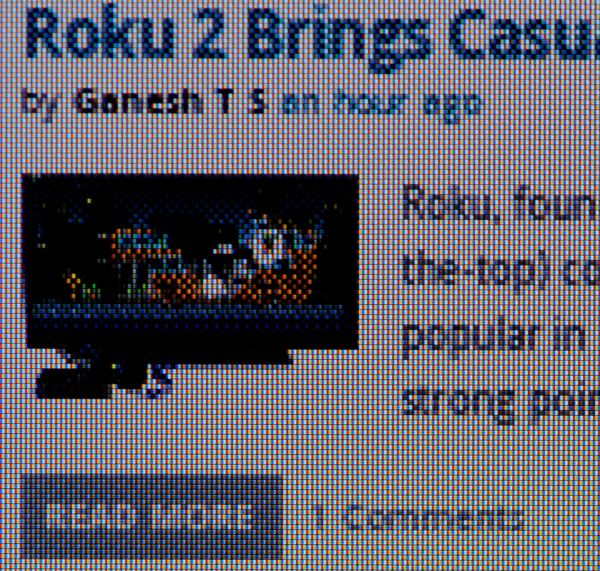

Left: Droid 3 with RGBW PenTile, Right: Droid 2 with RGB Stripe
Unlike the other RGBG PenTile which adorned AMOLED displays before Super AMOLED Plus swung around, I find RGBW much easier to stomach and completely readable when presented with black on white UIs. Colors still have visible grain, as do some UI elements, but the Droid 3’s 4” display makes this considerably less noticeable than the same resolution on the Droid X2. Only on bright colors is that extra space due to the fourth subpixel readily visible, and thanks to our color-specific visual acuity, greens are the most visible.
I immediately noticed out of the box with the Droid 3 that it wasn’t as super bright as the Droid X2, which was itself almost shockingly bright. That said, the Droid 3 is no slouch and is likewise nice and contrasty as well.
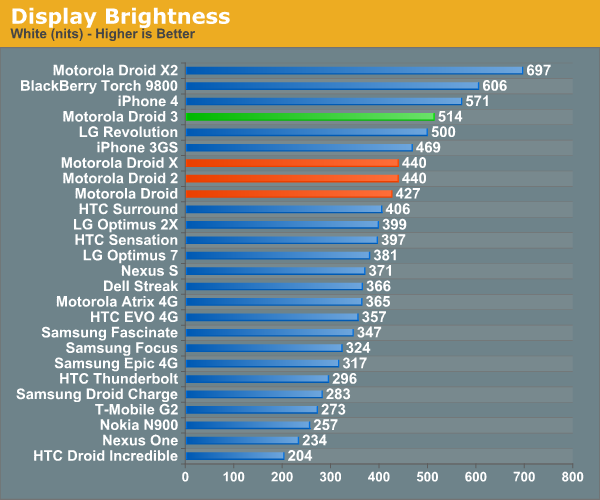
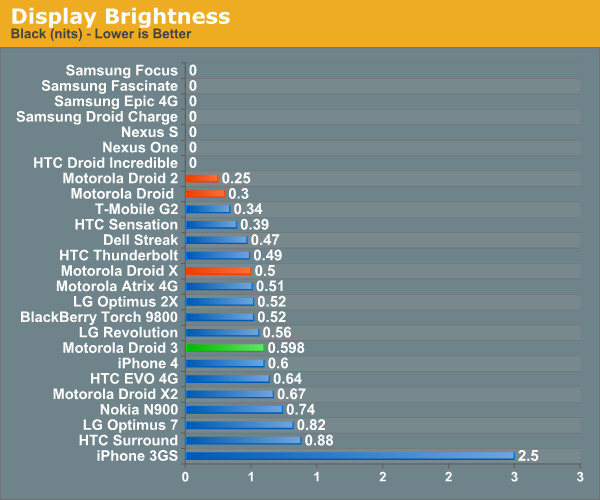

We’re still making plots of brightness (white and black), and white point at 25% brightness steps. The Droid 3’s white point tracking is slightly different from the X2’s despite also using RGBW. It ends up not being visibly blue like some of the AMOLED variants nor noticeably warm like some of the earlier Droid panels were in odd batches.

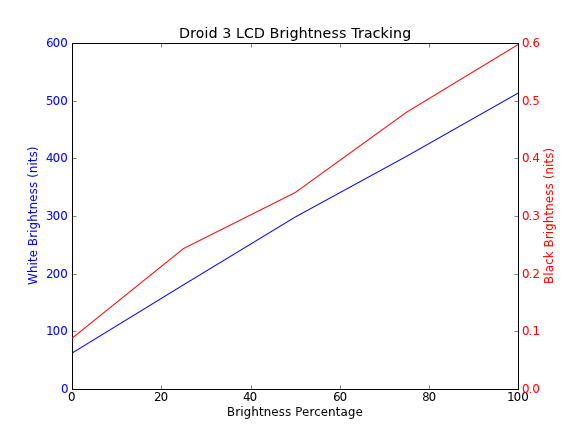
The next are of concern are viewing angles, which in my opinion the Droid 3 does very well at. I stuck the Droid 3 next to the Droid 2 and shot some pics of it at different angles. It’s surprising to me in retrospect how much color shift and contrast reduction there is in the old Droid 2 by comparison. In this regard, the Droid 3’s display is a clear step forwards.
Outdoor viewing angles are decent on the Droid 3 are pretty good but not totally perfect. RGBW helps keep brightness punchy but in my mind outdoor viewing remains an unsolved problem for just about everyone.








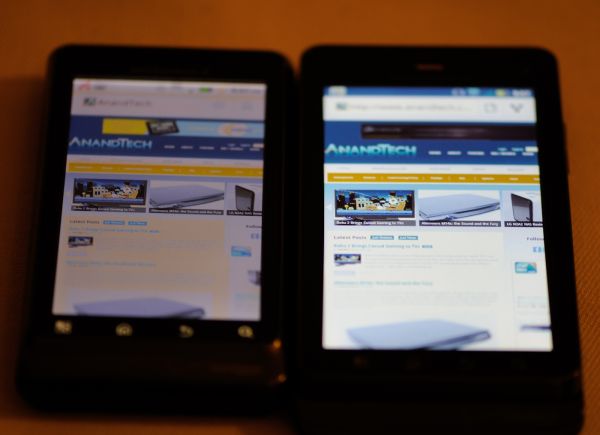
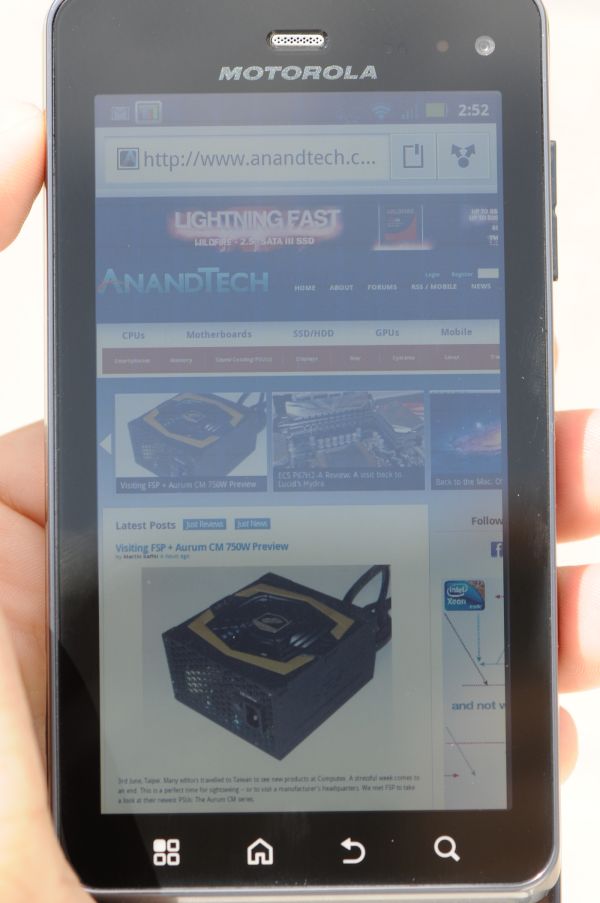








84 Comments
View All Comments
anandtech pirate - Sunday, July 31, 2011 - link
hmm, I was thinking about the Sensation vs. Evo3D, one has 768mb of ram while the other has 1GB or ram. The sensation suffers from noticeable lag on the homescreen where as the Evo3D is much smoother. this might be a sense 3.0 problem though as it's a resource hog.themossie - Sunday, July 31, 2011 - link
The extra RAM makes a huge difference when it comes to multitasking.With my Droid 1 the home screen always reloads when I leave an application, and true multitasking is impossible as I can't keep multiple applications in memory.
Droid 1 is significantly hampered by 256 MB. Droid 2 has 512 MB. Droid 3 should have more. Most of the Many competitive phones have 768 MB+ - (offhand the Droid Incredible 2 and MyTouch 4g) or 1 gb (Evo 3D, Atrix 4G) and RAM is cheap...
512 is acceptable now, but don't think in terms of today - what will the minimum requirements be to run Android in 1 year? 2 years?
Reikon - Sunday, July 31, 2011 - link
I was wondering about the Evo 3d review too. Didn't Brian say it was supposed to be out weeks ago?mike8675309 - Tuesday, August 2, 2011 - link
I agree... More memory. The dual core Moto Atrix comes with 1gig of RAM. Verizon has been notoriously stingy with RAM in the phones they deliver.bishless - Saturday, July 30, 2011 - link
I saw "Wetmore" in the maps screenshot and instantly thought, "Holy crap, this writer is in Tucson!"... I looked a little closer and saw Ruthraff and felt proud enough to reveal my detective skills in the article comments... Then a couple pages later, there's the weather widget obviously displaying "Tucson". Heh.So much for detective work.
I see you're aware of Cartel Coffee Lab... we ought to meet for coffee sometime!
Brian Klug - Saturday, July 30, 2011 - link
Yeah, always been here in Tucson ;)I hang out at Cartel a lot, absolutely!
-Brian
GotnoRice - Saturday, July 30, 2011 - link
While having numbers on top is sort of nice, they failed hard when it comes to the most basic element- the orientation of the QWERTY keysLook down at the keyboard right in front of you. The "S" key in the middle row should be directly above the gap between the "Z" and "X" keys. It should straddle the gap between those keys almost perfectly.
Yet on the Droid 3 the "S" key is almost DIRECTLY on top of the "X" key. Simply put, the rows are misaligned.
The reason people like a QWERTY keyboard is because it's a layout they are already familiar. That fact is incompatible with the idea of randomly adjusting the rows in relation to each other as if it's arbitrary; it's not.
They got this mostly right with the Droid 2 keyboard, how did they get it so wrong with the Droid 3?
Pete_ - Saturday, July 30, 2011 - link
Check your facts: the Tegra 2 chipset does not support LPDDR2 (333/266 MHz) and is limited to only 133 MHz DDR. I've owned the DX2 and returned it for the Droid 3... proof is in the pudding.Brian Klug - Saturday, July 30, 2011 - link
Hmm, I'm not sure about that: http://www.nvidia.com/object/tegra-2.html then look under Memory Frequency.We've independently confirmed a few times them using LPDDR2-600, for example on the Optimus 2X.
ol1bit - Saturday, July 30, 2011 - link
I'm glad you posted so many photos, but the blue tint on the flash enabled photo is terrible.Even the video has a tad of blue tint compared with the Cannon.
I wonder if they will do an update to fix that with this phone, or if this is just a jump step phone with no marketing, just to keep money flowing in till the Bionic comes out?